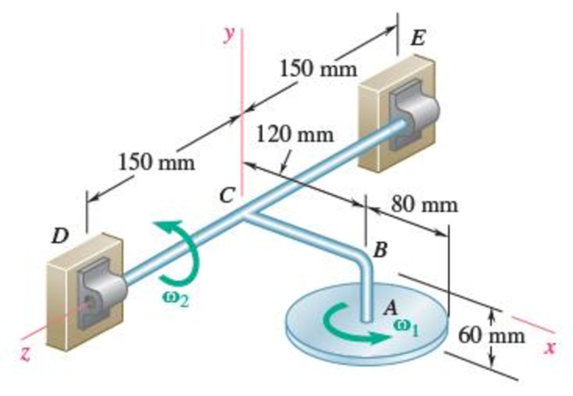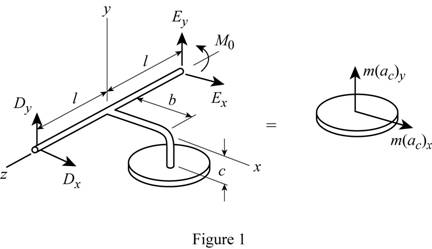
Concept explainers
A 2.5-kg homogeneous disk of radius 80 mm rotates at the constant rate ω1 = 50 rad/s with respect to arm ABC, which is welded to a shaft DCE. Knowing that at the instant shown, shaft DCE has an angular velocity ω2 = (12 rad/s)k and an angular acceleration α2 = (8 rad/s2)k, determine (a) the couple that must be applied to shaft DCE to produce that acceleration, (b) the corresponding dynamic reactions at D and E.

Fig. P18.103 and P18.104
(a)
The couple which must be applied to shaft DCE to produce that acceleration.
Answer to Problem 18.104P
The couple which must be applied to shaft DCE to produce that acceleration is
Explanation of Solution
Given information:
The mass (m) of the disk is 2.5kg.
The radius (r) of the disk Ais 80 mm.
The angular velocity
The angular acceleration
Calculation:
The angular velocity
Write the equation of angular velocity of disk A
Write the equation of angular velocity
Find the equation of angular velocity
Substitute 0 for
Find the equation of angular momentum about A
Here,
Substitute 0 for
Find the rate of change of angular momentum
Here,
Write the equation of vector form of angular velocity
Write the equation of the rate of change of angular momentum about A
Substitute
Write the equation mass moment of inertia
Write the equation mass moment of inertia
Substitute
Find the position vector
Here, b is the horizontal distance and c is the vertical distance.
Write the equation of velocity
Substitute
Write the equation of acceleration of the mass center A of the disk.
Substitute
Sketch the free body diagram and kinetic diagram of the system as shown in Figure (1).

Refer Figure (1),
Apply Newton’s law of motion.
Substitute
Equate i-vector coefficients in Equation (4).
Equate j-vector coefficients in Equation (4).
Find the rate of change of angular momentum about E
Here,
Substitute
Apply matrix multiplication,
Take moment about E.
Here,
The moment at E is equal to the rate of change of angular momentum at E.
Equate Equation (7) and (8).
Convert the unit of radius from mm to m.
Convert the unit of b from mm to m.
Convert the unit of c from mm to m.
Convert the unit of l from mm to m.
Find the couple
Equate
Substitute 2.5 kg for
Thus, the couple which must be applied to shaft DCE to produce that acceleration is
(b)
Find the corresponding dynamic reactions at D and E.
Answer to Problem 18.104P
The dynamic reaction at D is
The dynamic reaction at E is
Explanation of Solution
Calculation:
Find the component of dynamic reaction
Equate
Substitute 2.5 kg for
Find the component of dynamic reaction
Equate
Substitute 2.5 kg for
Find the dynamic reaction at D using the equation:
Substitute
Thus, the dynamic reaction at D is
Find the component of dynamic reaction
Substitute Equation (11) in (5).
Substitute 2.5 kg for
Find the component of dynamic reaction
Substitute Equation (12) in (6).
Substitute 2.5 kg for
Find the dynamic reaction at E using the equation:
Substitute
Thus, the dynamic reaction at E is
Want to see more full solutions like this?
Chapter 18 Solutions
VEC MECH 180-DAT EBOOK ACCESS(STAT+DYNA)
- reading is 0.4 mas SHOWN. Assume h₁ = 0.4 m, h₂ = 0.5 m. (a) Do you know the specific weight of mercury? (b) Do you know the specific weight of gasoline? (c) Do you know the specific weight of oil? (a) YHg = 133,000 (b) Ygas = 6867 (c) Yoil = 8829 eTextbook and Media Part 2 N/m³ N/m³ N/m³ A+ Gasoline t +B Oil -Mercury Attempts: unlimited Did you calculate the pressure difference between two locations using the correct specific weight? Did you assume that the pressures in fluid are the same in a horizontal plane even though they are in different tubes? Are the calculated pressures in a column of fluid always higher at lower elevations? Did you account for the fact that the two horizontal tubes of the U-tube are above the ground? Concepts: The pressure in a fluid is a function of the specific weight of the fluid and the height relative to a reference. Pressure is constant in a horizontal plane of a continuous mass of fluid. (a) What is the initial pressure difference? (PA-PB) (b) What is…arrow_forwardFind the solution of the following Differential Equations 1) "-4y+3y=0 3) "+16y=0 2) y"-16y=0 4) y"-y-6y=0 5) y"+2y=0 7) y"+y=0, (#0) 9) y"-y=0, y(0) = 6, y'(0) = -4 11) y"-4y+3y=0, y(0)=-1, 13) y'(0) = -5 "+2y+2y=0 15) y"-9y=0 17) y"-4y=0 6) y"-2y+2y=0 8) "+4y+5y=0 10) y"-9y=0, y(0) = 2, y'(0) = 0 12) y"-3y+2y= 0, y(0)=-1, y'(0) = 0 14) 4y+4y+y=0 16) "+6y+12y=0 18) 4y+4y+17y=0arrow_forwardAccess Pearson Mastering Engineering Back to my courses Course Home Course Home Scoresarrow_forward
- Access Pearson Mastering Engineering Back to my courses Course Home Course Home Scores Review Next >arrow_forwardAccess Pearson Course Home Scoresarrow_forwardAccess Pearson Mastering Engineering Back to my courses Course Home Course Home Scoresarrow_forwardarrow_back_iosSEE MORE QUESTIONSarrow_forward_ios
 Elements Of ElectromagneticsMechanical EngineeringISBN:9780190698614Author:Sadiku, Matthew N. O.Publisher:Oxford University Press
Elements Of ElectromagneticsMechanical EngineeringISBN:9780190698614Author:Sadiku, Matthew N. O.Publisher:Oxford University Press Mechanics of Materials (10th Edition)Mechanical EngineeringISBN:9780134319650Author:Russell C. HibbelerPublisher:PEARSON
Mechanics of Materials (10th Edition)Mechanical EngineeringISBN:9780134319650Author:Russell C. HibbelerPublisher:PEARSON Thermodynamics: An Engineering ApproachMechanical EngineeringISBN:9781259822674Author:Yunus A. Cengel Dr., Michael A. BolesPublisher:McGraw-Hill Education
Thermodynamics: An Engineering ApproachMechanical EngineeringISBN:9781259822674Author:Yunus A. Cengel Dr., Michael A. BolesPublisher:McGraw-Hill Education Control Systems EngineeringMechanical EngineeringISBN:9781118170519Author:Norman S. NisePublisher:WILEY
Control Systems EngineeringMechanical EngineeringISBN:9781118170519Author:Norman S. NisePublisher:WILEY Mechanics of Materials (MindTap Course List)Mechanical EngineeringISBN:9781337093347Author:Barry J. Goodno, James M. GerePublisher:Cengage Learning
Mechanics of Materials (MindTap Course List)Mechanical EngineeringISBN:9781337093347Author:Barry J. Goodno, James M. GerePublisher:Cengage Learning Engineering Mechanics: StaticsMechanical EngineeringISBN:9781118807330Author:James L. Meriam, L. G. Kraige, J. N. BoltonPublisher:WILEY
Engineering Mechanics: StaticsMechanical EngineeringISBN:9781118807330Author:James L. Meriam, L. G. Kraige, J. N. BoltonPublisher:WILEY





